| Reviews & Columns |
|
Reviews DVD TV on DVD Blu-ray 4K UHD International DVDs In Theaters Reviews by Studio Video Games Features Collector Series DVDs Easter Egg Database Interviews DVD Talk Radio Feature Articles Columns Anime Talk DVD Savant Horror DVDs The M.O.D. Squad Art House HD Talk Silent DVD
|
DVD Talk Forum |
|
|
| Resources |
|
DVD Price Search Customer Service #'s RCE Info Links |
|
Columns
|
|
|
Pixar Short Films Collection - Volume 1
Walt Disney Studios Home Entertainment // Unrated // November 6, 2007
List Price: $34.99 [Buy now and save at Amazon]
"Art challenges technology, and technology inspires the art. That's it, in a nutshell, the way we work at Pixar."
- John Lasseter
Computer animation may seem inescapable these days, having all but replaced traditional cel animation and accessible enough that someone with a regular desktop PC and off-the-shelf software from Best Buy can still do some amazing work. This is all fairly recent in the grand scheme of things, though. Twenty-five years ago,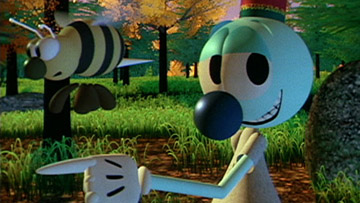 a feature-length computer animated film was still a distant dream. There weren't computer animators in the sense we think of now; these tech demos generally ran less than a minute and demanded months of intensely mathematical computations by computer scientists with white lab coats, scruffy beards, reams of graph paper, and Ph.D.s plastered across their walls. The Graphics Group at Lucasfilm was even more ambitious, though, bringing onboard a young animator named John Lasseter who background was sketching with pencil and paper, not in convoluted algorithms or linear algebra. Their first short film, The Adventures of André and Wally B., would've been technically groundbreaking on the merits of its particle system and use of motion blur alone, but what really won it such deafening applause at SIGGRAPH in 1984 was its characters...its personality...neither of which had really ever been attempted before in the digital domain. Over the years, Pixar would continue to advance both the science and the art of computer animation with its short films, continuing to use shorts today as a test bed for new talent and compelling ideas. This first collection of Pixar's shorts spans nearly a quarter-century and contains the studio's first thirteen shorts, everything from 1984's The Adventures of André and Wally B. as an arm of Lucasfilm to Gary Rydstrom's Lifted that debuted earlier this year.
a feature-length computer animated film was still a distant dream. There weren't computer animators in the sense we think of now; these tech demos generally ran less than a minute and demanded months of intensely mathematical computations by computer scientists with white lab coats, scruffy beards, reams of graph paper, and Ph.D.s plastered across their walls. The Graphics Group at Lucasfilm was even more ambitious, though, bringing onboard a young animator named John Lasseter who background was sketching with pencil and paper, not in convoluted algorithms or linear algebra. Their first short film, The Adventures of André and Wally B., would've been technically groundbreaking on the merits of its particle system and use of motion blur alone, but what really won it such deafening applause at SIGGRAPH in 1984 was its characters...its personality...neither of which had really ever been attempted before in the digital domain. Over the years, Pixar would continue to advance both the science and the art of computer animation with its short films, continuing to use shorts today as a test bed for new talent and compelling ideas. This first collection of Pixar's shorts spans nearly a quarter-century and contains the studio's first thirteen shorts, everything from 1984's The Adventures of André and Wally B. as an arm of Lucasfilm to Gary Rydstrom's Lifted that debuted earlier this year.
The Adventures of André and Wally B. (1984) doesn't really have a story -- it's a guy who darts away after waking up to find a bee staring him squarely in the face. Though technically revolutionary for its time, it's most notable today for being the first short by the team that would go on to found Pixar, and this collection marks the first time the short has been available on DVD or Blu-ray. Luxo Jr. (1986) is the most familiar of these early shorts, released theatrically alongside Toy Story 2 and lending Pixar its iconic logo. Visually, it's fairly simplistic; there's no camera movement, and the short takes place entirely against a black backdrop and a wooden floor. What's intriguing, though, is how two lamps -- one a parent and the other clearly its child -- playing with a ball can be so personable, running through a wide array of convincing emotions without a line of dialogue or any facial expressions. Its effectiveness is truly a testament to John Lasseter's skill as a filmmaker. Similarly, Red's Dream (1987) leaves a similar emotional impact in this dark and moody piece about an unwanted unicycle in a bike shop. Draped with a 50% off tag, Red spends a rainy night dreaming about stealing the show in a circus act, only to wake up from his fantasy and slink dejectedly into a corner. It's a premise that lends itself to a cheerful, sunny ending, yet Lasseter has the conviction to avoid taking the easy way out.
1988's Tin Toy won Pixar an Academy Award, the first time a computer animated short had been honored with one of the golden statuettes. Clearly paving the way for Toy Story, the short is about a baby that playfully smashes everything he can get his hands on, and a one-man-band tin toy is determined to escape his slobber-soaked clutches. Our hero bravely ventures out from under the couch when the rugrat starts wailing, only to find himself ignored when the baby decides he'd just as soon futz around with a box and a paper shopping bag instead. Tin Toy is the first of the films that feels like a vintage Disney or Merry Melodies short, unweaving a more robust story with a complete beginning, middle, and end. Knick Knack (1989) has a similar feel, taking quite a bit of inspiration from Chuck Jones as a snowman trapped in a snowglobe tries desperately to escape from his glassy prison to get his hands on a bikini-clad souvenir on the other side of the cluttered shelf. Knick Knack is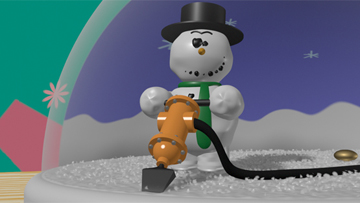 played purely for laughs and has the most smirkingly clever sense of humor of any of the first five shorts. My only disappointment is that Pixar only included the revised version that played alongside Finding Nemo and the 3-D release of The Nightmare Before Christmas, deflating the buxom souvenir to something a little more...y'know, modest. Not that I'm desperate to see a set of CG animated boobs, but for something geared towards collectors in the first place, this Blu-ray disc really should've included both versions.
played purely for laughs and has the most smirkingly clever sense of humor of any of the first five shorts. My only disappointment is that Pixar only included the revised version that played alongside Finding Nemo and the 3-D release of The Nightmare Before Christmas, deflating the buxom souvenir to something a little more...y'know, modest. Not that I'm desperate to see a set of CG animated boobs, but for something geared towards collectors in the first place, this Blu-ray disc really should've included both versions.
Additional shorts were put on hold as Pixar powered through the production of their first feature film, reviving the concept with Geri's Game (1998), which played before A Bug's Life theatrically. It's about a weathered old man playing a game of chess against himself in a deserted park, slowly trudging his way from one chair to another before leaping to life the instant he wraps his bony fingers around one of the game pieces. This is the first time a fairly realistic human had been attempted by Pixar, ignoring the creepy baby in Tin Toy and the simpler, more stylized characters in Toy Story, and the results are astonishing. What's really striking is how convincing, expressive, and realistic Geri's movements are, steering clear of the robotic motion in some earlier attempts, and how a character brought to life by a team of nearly twenty animators is so consistent from shot to shot. It's a beautifully shot, charming, clever, and astoundingly well-directed short.
For the Birds (2001) was paired with Monsters, Inc. theatrically, and it's a fairly simple short about a gaggle of tiny, tubby birds who snicker at a lanky, awkward critter only to have the tables completely upended against them in a matter of moments. I have to admit to not thinking all that much of Boundin' (2004), which preceded The Incredibles, a musical tale about a shorn sheep who learns to be comfortable with what's left of his body after his wool is shaved off, gleefully bounding around the lush countryside buck nekkid. Boundin' is easily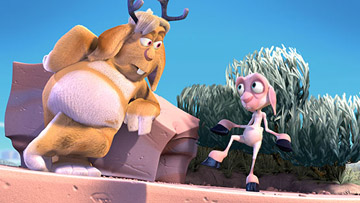 one of the most visually impressive shorts in this collection, but the bland folksy music and fairly familiar story leave it feeling kind of forgettable. One Man Band (2006), which played before Cars theatrically, is driven entirely by richly orchestrated, bouncy music as a pair of one-man bands square off in the hopes of winning a little girl's shiny gold coin. The last of the theatrically released shorts is Gary Rydstrom's Lifted (2007), which played before Ratatouille. Lifted follows a neophyte alien who's trying to get the hang of the whole Midwestern abduction thing, baffled by the mile-long bank of switches and not quite able to navigate his soundly sleeping target through a window and instead into a wall. Again and again and again and again and...you get the idea. It's a clever twist on a familiar idea, and having a legend in sound design like Rydstrom helming the short means he's more readily able to tell a story purely through sound, something he does frequently throughout Lifted with some of its biggest laughs coming from things tumbling around out of sight.
one of the most visually impressive shorts in this collection, but the bland folksy music and fairly familiar story leave it feeling kind of forgettable. One Man Band (2006), which played before Cars theatrically, is driven entirely by richly orchestrated, bouncy music as a pair of one-man bands square off in the hopes of winning a little girl's shiny gold coin. The last of the theatrically released shorts is Gary Rydstrom's Lifted (2007), which played before Ratatouille. Lifted follows a neophyte alien who's trying to get the hang of the whole Midwestern abduction thing, baffled by the mile-long bank of switches and not quite able to navigate his soundly sleeping target through a window and instead into a wall. Again and again and again and again and...you get the idea. It's a clever twist on a familiar idea, and having a legend in sound design like Rydstrom helming the short means he's more readily able to tell a story purely through sound, something he does frequently throughout Lifted with some of its biggest laughs coming from things tumbling around out of sight.
Aside from Ratatouille's Your Friend, The Rat, all of the shorts created specifically for the DVD and Blu-ray releases of Pixar's films have also made their way into this disc. 2002's Mike's New Car -- more than 15 years after Pixar's first stab at an animated short -- is the first of these short subjects to feature any spoken dialogue. Mike is showing off his new hot rod to his pal Sully from Monsters, Inc., only he hasn't quite gotten the hang of what the eight hojillion buttons on the dashboard do, exactly. So, yeah: lotsa inadvertent windshield wiping, Mike getting his keister cooked on the V8 engine, and, um, Mike's first insurance claim, I'd bet. Jack-Jack Attack (2005) fills in one of the gaps in The Incredibles as bracefaced babysitter Kari suffers through the tiny little tyke discovering his wide assortment of superpowers. The seven minute Mater and the Ghostlight (2006) piles most of Cars' key vocal talent back into the recording studio for another stroll through Radiator Springs. After a night of spirited (yuk-yuk) practical jokes, Mater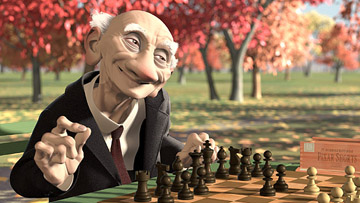 finds himself stranded alone with the Ghostlight, an eerie blue orb that skulks the darkened roads of Route 66.
finds himself stranded alone with the Ghostlight, an eerie blue orb that skulks the darkened roads of Route 66.
This first volume of Pixar's shorts is really geared towards collectors, not having quite the wide appeal of the studio's feature-length films. The younger crowd probably won't think much of the earliest of the shorts on this disc, and unless they're fussy about sparkling high definition presentations or particularly enjoy giving audio commentaries a spin, they likely won't mind sticking with what they already have on DVD. However, viewers with a deep interest in computer animation and a particular passion for Pixar's stellar body of work ought to find this collection of shorts to be essential viewing. Watching the artform evolve -- decades worth of research and intensely hard work condensed down to some 55 minutes -- is fascinating to me as an animation enthusiast. Admittedly, its earliest shorts are more compelling for what they represent rather than entertaining all that much on their lonesome, but having them readily on-hand in high definition is greatly appreciated. Seeing some of the studio's more recent and more familiar shorts get a sterling upgrade to 1080p makes the collection well-worth the modest asking price, particularly considering the assortment of commentary tracks and the high definition featurette that give an even greater appreciation for what Pixar has accomplished over the years with their groundbreaking short films. Highly Recommended.
Video: The shorts in this collection chart the evolution of computer graphics from technical demonstrations at SIGGRAPH to a lush, cinematic artform, so it's understandable that the earliest shorts are fairly crude by comparison. The first four, in fact, are rather soft, drab, and appear to be culled from film transfers, which isn't unexpected considering the archaic hardware used to render them in the first place have probably long since been mothballed. From the remastered Knick Knack on, the shorts boast the polish and glossy sheen associated with Pixar's artistry. Of the thirteen shorts on this disc, Boundin' is easily the most jaw-dropping, from its sumptuous colors to its striking depth and dimensionality. Its earliest shorts aside, crispness and clarity are both deeply impressive, particularly the plumage in For the Birds, the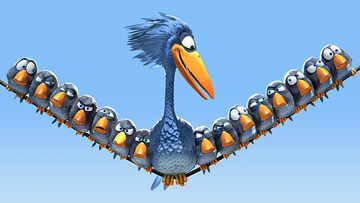 distinctness of each and every one of Sully's hairs in Mike's New Car, and the tiniest flecks of dust illuminated in Lifted's incandescent tractor beam. The aspect ratio varies from short to short, but it generally falls comfortably around 1.78:1, and all have been masterfully compressed with Disney's preferred AVC codec.
distinctness of each and every one of Sully's hairs in Mike's New Car, and the tiniest flecks of dust illuminated in Lifted's incandescent tractor beam. The aspect ratio varies from short to short, but it generally falls comfortably around 1.78:1, and all have been masterfully compressed with Disney's preferred AVC codec.
Audio: All thirteen shorts are accompanied by an outstanding 24-bit PCM soundtrack, almost all of which are presented in 5.1. The sole exception is the stereo track that backs The Adventures of André and Wally B., although its clarity and detail are both so robust -- and the sound design makes such extensive use of stereo effects and pans from left to right -- that I doubt I would've noticed if I hadn't mashed the 'Display' button on the remote. All of this shorts make wonderful use of sound, teeming with color in the surround channels as Knick Knack's determined snowman swirls around his globe, a lapping, lazy stream bubbles in the background in Boundin', and cars careen from one end of the screen to the other in Mater and the Ghostlight.
The fact that less than a third of these shorts have any dialogue makes the use of sound even more essential than usual. The sound design really isn't all that bombastic for many of the shorts -- not until the more hyperkinetic Jack-Jack Attack, to any great extent -- but they all have a strong sense of directionality and make effective use of the surround channels. The music used throughout these shorts is robust as well, with the lower frequencies coming more and more into play from Mike's New Car and on. Bass response and just the overall fidelity and clarity are phenomenal, from the throaty rumble of the Screaming Banshee in Mater and the Ghostlight to the sense that I could pick out each and every leaf that's rustling in Lifted. My only complaint is that there was a fairly noticeable hiss to For the Birds, but that aside, the PCM audio is tremendous -- a dramatic improvement over anything DVD has to offer and eclipsing my expectations.
Dolby Digital 5.1 tracks and subtitles are also offered in English, French, and Spanish.
Extras: By far the highlight of the set's extras is "The Pixar Shorts: A Short History". Presented in high definition, this 23 minute featurette focuses on Pixar's earliest years, from its days as a division of Lucasfilm leading up to the deal they struck with Disney to produce Toy Story. It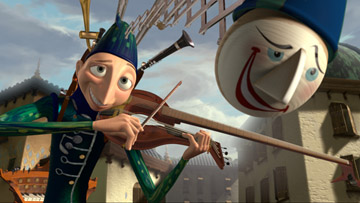 opens by giving viewers an impression what the state of computer graphics was in the early '80s -- the domain of researchers in stuffy white labcoats toiling away on quarter-million dollar hardware with the tiniest fraction of the computing power of a modern cell phone. In an era when CG didn't amount to more than cold, sterile tech demos, this division of Lucasfilm had the foresight to hire a traditional pencil-and-paper animator, and the close collaboration between John Lasseter and a tiny handful of programmers revolutionized computer graphics both technically and artistically.
opens by giving viewers an impression what the state of computer graphics was in the early '80s -- the domain of researchers in stuffy white labcoats toiling away on quarter-million dollar hardware with the tiniest fraction of the computing power of a modern cell phone. In an era when CG didn't amount to more than cold, sterile tech demos, this division of Lucasfilm had the foresight to hire a traditional pencil-and-paper animator, and the close collaboration between John Lasseter and a tiny handful of programmers revolutionized computer graphics both technically and artistically.
Pixar's first five shorts are delved into in detail on both of those fronts, noting what Lasseter was aiming for artistically -- nimble, lithe characters in The Adventures of André and Wally B., the array of emotions in Luxo Jr., and Red's Dream's dark mood and pathos, for instance -- as well as the technical impact these shorts left on the artform. In an era when the struggling hardware company was barely kept afloat by sales of their imaging systems to oil companies and the medical community, Pixar's restructuring into a dedicated animation company is covered as well, taking viewers from its days doing animation for TV spots all the way to the realization of a dream they'd held since before Pixar's inception: a fully computer-rendered feature film. The featurette is driven by interviews with an extensive assortment of talent from Pixar's earliest days (an astonishing number of whom are still with the studio all these years later, which says quite a lot), also featuring a score of photographs and excerpts from many vintage home videos. "A Short History" helps put the earliest shorts on this disc in a context that makes them much easier to appreciate, serving as both an engaging history of Pixar and the evolution of computer animation as a whole, as well as explaining why the studio continues producing these sorts of short films today.
All but two of the shorts are accompanied by audio commentaries with the filmmakers involved. (Mike's New Car has the directors' precocious kids gabbing about how they think their dads make their movies, and Jack-Jack Attack doesn't have a commentary at all.) The first five shorts feature John Lasseter, Eben Ostby, and Bill Reeves, although because the disc's featurette covers these shorts in such detail anyway, they tend to repeat themselves. Red's Dream gets the most substantial commentary of the first five shorts, with Lasseter noting how several individual projects were brought together to make the rather melancholy short film.
The participants rotate from there, beginning with director Jan Pinkava as he discusses the challenges of having his team of nineteen animators bring a single fairly realistic human to life in the digital domain in Geri's Game. Ralph Eggleston chats about the names and personalities of some of the key critters in For the Birds, pointing out the work involved in making the plumage behave realistically and the effort that went into animating the discarded feathers as they each flutter down from the sky. Bud Luckey talks about how he originally pitched Boundin', which he notes was inspired by his days growing up in Montana and features models creatively lifted from several different Pixar projects. The discarded original concept for One Man Band is brought up by composer Michael Giacchino and directors Andrew Jimenez and Mark Andrews, who discuss how to convincingly make a single musician sound as if he's believably belting out the work of a 38 piece orchestra.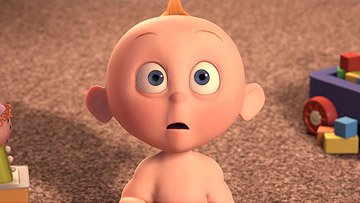 John Lasseter returns alongside co-director Dan Scanlon for Mater and the Ghostlight. It's one of the longer shorts on the disc, giving the two of them enough breathing room to chat about how many of the elements were recycled from Cars proper, Steve Purcell's relentless monster doodling being put to good use for the very last gag, and the inclusion of the late Joe Ranft's conceptual art over the end credits. Finally, Gary Rydstrom's commentary for Lifted makes it clear how much his experience in sound design influenced his approach to the short, from its creative use of sound to the newbie alien's rampage reflecting Rydstrom's own desire to maul a similarly sprawling mixing console.
John Lasseter returns alongside co-director Dan Scanlon for Mater and the Ghostlight. It's one of the longer shorts on the disc, giving the two of them enough breathing room to chat about how many of the elements were recycled from Cars proper, Steve Purcell's relentless monster doodling being put to good use for the very last gag, and the inclusion of the late Joe Ranft's conceptual art over the end credits. Finally, Gary Rydstrom's commentary for Lifted makes it clear how much his experience in sound design influenced his approach to the short, from its creative use of sound to the newbie alien's rampage reflecting Rydstrom's own desire to maul a similarly sprawling mixing console.
Aside from the cute but quickly tiresome track with the directors' tykes over Mike's New Car, all of these tracks are well-worth a listen.
Rounding out the extras are four shorts with Luxo and Luxo Jr. produced for Sesame Street. These clips, presented in fuzzy standard definition video and running anywhere from twenty seconds or so to right at a minute in length, illustrate direction, weight, the difference between front and back, and the concept of surprise. Luxo Jr. is also lavished with some additional attention in an Easter egg that reveals a wireframe version of the original short.
The disc opens with high-definition plugs for Ratatouille and Meet the Robinsons.
Conclusion: Although I'm not sure it'll hold much appeal to the younger crowd or those with more of a casual interest, this first collection of Pixar's short films is a near-essential purchase for the studio's rabid legion of fans. The majority of these shorts look stunning in high definition, backed by a tremendous uncompressed soundtrack and accompanied by a compelling set of revealing extras. Highly Recommended.
The images scattered around this review are promotional stills and aren't meant to represent the way these shorts look in high definition.
- John Lasseter
Computer animation may seem inescapable these days, having all but replaced traditional cel animation and accessible enough that someone with a regular desktop PC and off-the-shelf software from Best Buy can still do some amazing work. This is all fairly recent in the grand scheme of things, though. Twenty-five years ago,
 a feature-length computer animated film was still a distant dream. There weren't computer animators in the sense we think of now; these tech demos generally ran less than a minute and demanded months of intensely mathematical computations by computer scientists with white lab coats, scruffy beards, reams of graph paper, and Ph.D.s plastered across their walls. The Graphics Group at Lucasfilm was even more ambitious, though, bringing onboard a young animator named John Lasseter who background was sketching with pencil and paper, not in convoluted algorithms or linear algebra. Their first short film, The Adventures of André and Wally B., would've been technically groundbreaking on the merits of its particle system and use of motion blur alone, but what really won it such deafening applause at SIGGRAPH in 1984 was its characters...its personality...neither of which had really ever been attempted before in the digital domain. Over the years, Pixar would continue to advance both the science and the art of computer animation with its short films, continuing to use shorts today as a test bed for new talent and compelling ideas. This first collection of Pixar's shorts spans nearly a quarter-century and contains the studio's first thirteen shorts, everything from 1984's The Adventures of André and Wally B. as an arm of Lucasfilm to Gary Rydstrom's Lifted that debuted earlier this year.
a feature-length computer animated film was still a distant dream. There weren't computer animators in the sense we think of now; these tech demos generally ran less than a minute and demanded months of intensely mathematical computations by computer scientists with white lab coats, scruffy beards, reams of graph paper, and Ph.D.s plastered across their walls. The Graphics Group at Lucasfilm was even more ambitious, though, bringing onboard a young animator named John Lasseter who background was sketching with pencil and paper, not in convoluted algorithms or linear algebra. Their first short film, The Adventures of André and Wally B., would've been technically groundbreaking on the merits of its particle system and use of motion blur alone, but what really won it such deafening applause at SIGGRAPH in 1984 was its characters...its personality...neither of which had really ever been attempted before in the digital domain. Over the years, Pixar would continue to advance both the science and the art of computer animation with its short films, continuing to use shorts today as a test bed for new talent and compelling ideas. This first collection of Pixar's shorts spans nearly a quarter-century and contains the studio's first thirteen shorts, everything from 1984's The Adventures of André and Wally B. as an arm of Lucasfilm to Gary Rydstrom's Lifted that debuted earlier this year. The Adventures of André and Wally B. (1984) doesn't really have a story -- it's a guy who darts away after waking up to find a bee staring him squarely in the face. Though technically revolutionary for its time, it's most notable today for being the first short by the team that would go on to found Pixar, and this collection marks the first time the short has been available on DVD or Blu-ray. Luxo Jr. (1986) is the most familiar of these early shorts, released theatrically alongside Toy Story 2 and lending Pixar its iconic logo. Visually, it's fairly simplistic; there's no camera movement, and the short takes place entirely against a black backdrop and a wooden floor. What's intriguing, though, is how two lamps -- one a parent and the other clearly its child -- playing with a ball can be so personable, running through a wide array of convincing emotions without a line of dialogue or any facial expressions. Its effectiveness is truly a testament to John Lasseter's skill as a filmmaker. Similarly, Red's Dream (1987) leaves a similar emotional impact in this dark and moody piece about an unwanted unicycle in a bike shop. Draped with a 50% off tag, Red spends a rainy night dreaming about stealing the show in a circus act, only to wake up from his fantasy and slink dejectedly into a corner. It's a premise that lends itself to a cheerful, sunny ending, yet Lasseter has the conviction to avoid taking the easy way out.
1988's Tin Toy won Pixar an Academy Award, the first time a computer animated short had been honored with one of the golden statuettes. Clearly paving the way for Toy Story, the short is about a baby that playfully smashes everything he can get his hands on, and a one-man-band tin toy is determined to escape his slobber-soaked clutches. Our hero bravely ventures out from under the couch when the rugrat starts wailing, only to find himself ignored when the baby decides he'd just as soon futz around with a box and a paper shopping bag instead. Tin Toy is the first of the films that feels like a vintage Disney or Merry Melodies short, unweaving a more robust story with a complete beginning, middle, and end. Knick Knack (1989) has a similar feel, taking quite a bit of inspiration from Chuck Jones as a snowman trapped in a snowglobe tries desperately to escape from his glassy prison to get his hands on a bikini-clad souvenir on the other side of the cluttered shelf. Knick Knack is
 played purely for laughs and has the most smirkingly clever sense of humor of any of the first five shorts. My only disappointment is that Pixar only included the revised version that played alongside Finding Nemo and the 3-D release of The Nightmare Before Christmas, deflating the buxom souvenir to something a little more...y'know, modest. Not that I'm desperate to see a set of CG animated boobs, but for something geared towards collectors in the first place, this Blu-ray disc really should've included both versions.
played purely for laughs and has the most smirkingly clever sense of humor of any of the first five shorts. My only disappointment is that Pixar only included the revised version that played alongside Finding Nemo and the 3-D release of The Nightmare Before Christmas, deflating the buxom souvenir to something a little more...y'know, modest. Not that I'm desperate to see a set of CG animated boobs, but for something geared towards collectors in the first place, this Blu-ray disc really should've included both versions. Additional shorts were put on hold as Pixar powered through the production of their first feature film, reviving the concept with Geri's Game (1998), which played before A Bug's Life theatrically. It's about a weathered old man playing a game of chess against himself in a deserted park, slowly trudging his way from one chair to another before leaping to life the instant he wraps his bony fingers around one of the game pieces. This is the first time a fairly realistic human had been attempted by Pixar, ignoring the creepy baby in Tin Toy and the simpler, more stylized characters in Toy Story, and the results are astonishing. What's really striking is how convincing, expressive, and realistic Geri's movements are, steering clear of the robotic motion in some earlier attempts, and how a character brought to life by a team of nearly twenty animators is so consistent from shot to shot. It's a beautifully shot, charming, clever, and astoundingly well-directed short.
For the Birds (2001) was paired with Monsters, Inc. theatrically, and it's a fairly simple short about a gaggle of tiny, tubby birds who snicker at a lanky, awkward critter only to have the tables completely upended against them in a matter of moments. I have to admit to not thinking all that much of Boundin' (2004), which preceded The Incredibles, a musical tale about a shorn sheep who learns to be comfortable with what's left of his body after his wool is shaved off, gleefully bounding around the lush countryside buck nekkid. Boundin' is easily
 one of the most visually impressive shorts in this collection, but the bland folksy music and fairly familiar story leave it feeling kind of forgettable. One Man Band (2006), which played before Cars theatrically, is driven entirely by richly orchestrated, bouncy music as a pair of one-man bands square off in the hopes of winning a little girl's shiny gold coin. The last of the theatrically released shorts is Gary Rydstrom's Lifted (2007), which played before Ratatouille. Lifted follows a neophyte alien who's trying to get the hang of the whole Midwestern abduction thing, baffled by the mile-long bank of switches and not quite able to navigate his soundly sleeping target through a window and instead into a wall. Again and again and again and again and...you get the idea. It's a clever twist on a familiar idea, and having a legend in sound design like Rydstrom helming the short means he's more readily able to tell a story purely through sound, something he does frequently throughout Lifted with some of its biggest laughs coming from things tumbling around out of sight.
one of the most visually impressive shorts in this collection, but the bland folksy music and fairly familiar story leave it feeling kind of forgettable. One Man Band (2006), which played before Cars theatrically, is driven entirely by richly orchestrated, bouncy music as a pair of one-man bands square off in the hopes of winning a little girl's shiny gold coin. The last of the theatrically released shorts is Gary Rydstrom's Lifted (2007), which played before Ratatouille. Lifted follows a neophyte alien who's trying to get the hang of the whole Midwestern abduction thing, baffled by the mile-long bank of switches and not quite able to navigate his soundly sleeping target through a window and instead into a wall. Again and again and again and again and...you get the idea. It's a clever twist on a familiar idea, and having a legend in sound design like Rydstrom helming the short means he's more readily able to tell a story purely through sound, something he does frequently throughout Lifted with some of its biggest laughs coming from things tumbling around out of sight. Aside from Ratatouille's Your Friend, The Rat, all of the shorts created specifically for the DVD and Blu-ray releases of Pixar's films have also made their way into this disc. 2002's Mike's New Car -- more than 15 years after Pixar's first stab at an animated short -- is the first of these short subjects to feature any spoken dialogue. Mike is showing off his new hot rod to his pal Sully from Monsters, Inc., only he hasn't quite gotten the hang of what the eight hojillion buttons on the dashboard do, exactly. So, yeah: lotsa inadvertent windshield wiping, Mike getting his keister cooked on the V8 engine, and, um, Mike's first insurance claim, I'd bet. Jack-Jack Attack (2005) fills in one of the gaps in The Incredibles as bracefaced babysitter Kari suffers through the tiny little tyke discovering his wide assortment of superpowers. The seven minute Mater and the Ghostlight (2006) piles most of Cars' key vocal talent back into the recording studio for another stroll through Radiator Springs. After a night of spirited (yuk-yuk) practical jokes, Mater
 finds himself stranded alone with the Ghostlight, an eerie blue orb that skulks the darkened roads of Route 66.
finds himself stranded alone with the Ghostlight, an eerie blue orb that skulks the darkened roads of Route 66. This first volume of Pixar's shorts is really geared towards collectors, not having quite the wide appeal of the studio's feature-length films. The younger crowd probably won't think much of the earliest of the shorts on this disc, and unless they're fussy about sparkling high definition presentations or particularly enjoy giving audio commentaries a spin, they likely won't mind sticking with what they already have on DVD. However, viewers with a deep interest in computer animation and a particular passion for Pixar's stellar body of work ought to find this collection of shorts to be essential viewing. Watching the artform evolve -- decades worth of research and intensely hard work condensed down to some 55 minutes -- is fascinating to me as an animation enthusiast. Admittedly, its earliest shorts are more compelling for what they represent rather than entertaining all that much on their lonesome, but having them readily on-hand in high definition is greatly appreciated. Seeing some of the studio's more recent and more familiar shorts get a sterling upgrade to 1080p makes the collection well-worth the modest asking price, particularly considering the assortment of commentary tracks and the high definition featurette that give an even greater appreciation for what Pixar has accomplished over the years with their groundbreaking short films. Highly Recommended.
Video: The shorts in this collection chart the evolution of computer graphics from technical demonstrations at SIGGRAPH to a lush, cinematic artform, so it's understandable that the earliest shorts are fairly crude by comparison. The first four, in fact, are rather soft, drab, and appear to be culled from film transfers, which isn't unexpected considering the archaic hardware used to render them in the first place have probably long since been mothballed. From the remastered Knick Knack on, the shorts boast the polish and glossy sheen associated with Pixar's artistry. Of the thirteen shorts on this disc, Boundin' is easily the most jaw-dropping, from its sumptuous colors to its striking depth and dimensionality. Its earliest shorts aside, crispness and clarity are both deeply impressive, particularly the plumage in For the Birds, the
 distinctness of each and every one of Sully's hairs in Mike's New Car, and the tiniest flecks of dust illuminated in Lifted's incandescent tractor beam. The aspect ratio varies from short to short, but it generally falls comfortably around 1.78:1, and all have been masterfully compressed with Disney's preferred AVC codec.
distinctness of each and every one of Sully's hairs in Mike's New Car, and the tiniest flecks of dust illuminated in Lifted's incandescent tractor beam. The aspect ratio varies from short to short, but it generally falls comfortably around 1.78:1, and all have been masterfully compressed with Disney's preferred AVC codec. Audio: All thirteen shorts are accompanied by an outstanding 24-bit PCM soundtrack, almost all of which are presented in 5.1. The sole exception is the stereo track that backs The Adventures of André and Wally B., although its clarity and detail are both so robust -- and the sound design makes such extensive use of stereo effects and pans from left to right -- that I doubt I would've noticed if I hadn't mashed the 'Display' button on the remote. All of this shorts make wonderful use of sound, teeming with color in the surround channels as Knick Knack's determined snowman swirls around his globe, a lapping, lazy stream bubbles in the background in Boundin', and cars careen from one end of the screen to the other in Mater and the Ghostlight.
The fact that less than a third of these shorts have any dialogue makes the use of sound even more essential than usual. The sound design really isn't all that bombastic for many of the shorts -- not until the more hyperkinetic Jack-Jack Attack, to any great extent -- but they all have a strong sense of directionality and make effective use of the surround channels. The music used throughout these shorts is robust as well, with the lower frequencies coming more and more into play from Mike's New Car and on. Bass response and just the overall fidelity and clarity are phenomenal, from the throaty rumble of the Screaming Banshee in Mater and the Ghostlight to the sense that I could pick out each and every leaf that's rustling in Lifted. My only complaint is that there was a fairly noticeable hiss to For the Birds, but that aside, the PCM audio is tremendous -- a dramatic improvement over anything DVD has to offer and eclipsing my expectations.
Dolby Digital 5.1 tracks and subtitles are also offered in English, French, and Spanish.
Extras: By far the highlight of the set's extras is "The Pixar Shorts: A Short History". Presented in high definition, this 23 minute featurette focuses on Pixar's earliest years, from its days as a division of Lucasfilm leading up to the deal they struck with Disney to produce Toy Story. It
 opens by giving viewers an impression what the state of computer graphics was in the early '80s -- the domain of researchers in stuffy white labcoats toiling away on quarter-million dollar hardware with the tiniest fraction of the computing power of a modern cell phone. In an era when CG didn't amount to more than cold, sterile tech demos, this division of Lucasfilm had the foresight to hire a traditional pencil-and-paper animator, and the close collaboration between John Lasseter and a tiny handful of programmers revolutionized computer graphics both technically and artistically.
opens by giving viewers an impression what the state of computer graphics was in the early '80s -- the domain of researchers in stuffy white labcoats toiling away on quarter-million dollar hardware with the tiniest fraction of the computing power of a modern cell phone. In an era when CG didn't amount to more than cold, sterile tech demos, this division of Lucasfilm had the foresight to hire a traditional pencil-and-paper animator, and the close collaboration between John Lasseter and a tiny handful of programmers revolutionized computer graphics both technically and artistically. Pixar's first five shorts are delved into in detail on both of those fronts, noting what Lasseter was aiming for artistically -- nimble, lithe characters in The Adventures of André and Wally B., the array of emotions in Luxo Jr., and Red's Dream's dark mood and pathos, for instance -- as well as the technical impact these shorts left on the artform. In an era when the struggling hardware company was barely kept afloat by sales of their imaging systems to oil companies and the medical community, Pixar's restructuring into a dedicated animation company is covered as well, taking viewers from its days doing animation for TV spots all the way to the realization of a dream they'd held since before Pixar's inception: a fully computer-rendered feature film. The featurette is driven by interviews with an extensive assortment of talent from Pixar's earliest days (an astonishing number of whom are still with the studio all these years later, which says quite a lot), also featuring a score of photographs and excerpts from many vintage home videos. "A Short History" helps put the earliest shorts on this disc in a context that makes them much easier to appreciate, serving as both an engaging history of Pixar and the evolution of computer animation as a whole, as well as explaining why the studio continues producing these sorts of short films today.
All but two of the shorts are accompanied by audio commentaries with the filmmakers involved. (Mike's New Car has the directors' precocious kids gabbing about how they think their dads make their movies, and Jack-Jack Attack doesn't have a commentary at all.) The first five shorts feature John Lasseter, Eben Ostby, and Bill Reeves, although because the disc's featurette covers these shorts in such detail anyway, they tend to repeat themselves. Red's Dream gets the most substantial commentary of the first five shorts, with Lasseter noting how several individual projects were brought together to make the rather melancholy short film.
The participants rotate from there, beginning with director Jan Pinkava as he discusses the challenges of having his team of nineteen animators bring a single fairly realistic human to life in the digital domain in Geri's Game. Ralph Eggleston chats about the names and personalities of some of the key critters in For the Birds, pointing out the work involved in making the plumage behave realistically and the effort that went into animating the discarded feathers as they each flutter down from the sky. Bud Luckey talks about how he originally pitched Boundin', which he notes was inspired by his days growing up in Montana and features models creatively lifted from several different Pixar projects. The discarded original concept for One Man Band is brought up by composer Michael Giacchino and directors Andrew Jimenez and Mark Andrews, who discuss how to convincingly make a single musician sound as if he's believably belting out the work of a 38 piece orchestra.
 John Lasseter returns alongside co-director Dan Scanlon for Mater and the Ghostlight. It's one of the longer shorts on the disc, giving the two of them enough breathing room to chat about how many of the elements were recycled from Cars proper, Steve Purcell's relentless monster doodling being put to good use for the very last gag, and the inclusion of the late Joe Ranft's conceptual art over the end credits. Finally, Gary Rydstrom's commentary for Lifted makes it clear how much his experience in sound design influenced his approach to the short, from its creative use of sound to the newbie alien's rampage reflecting Rydstrom's own desire to maul a similarly sprawling mixing console.
John Lasseter returns alongside co-director Dan Scanlon for Mater and the Ghostlight. It's one of the longer shorts on the disc, giving the two of them enough breathing room to chat about how many of the elements were recycled from Cars proper, Steve Purcell's relentless monster doodling being put to good use for the very last gag, and the inclusion of the late Joe Ranft's conceptual art over the end credits. Finally, Gary Rydstrom's commentary for Lifted makes it clear how much his experience in sound design influenced his approach to the short, from its creative use of sound to the newbie alien's rampage reflecting Rydstrom's own desire to maul a similarly sprawling mixing console. Aside from the cute but quickly tiresome track with the directors' tykes over Mike's New Car, all of these tracks are well-worth a listen.
Rounding out the extras are four shorts with Luxo and Luxo Jr. produced for Sesame Street. These clips, presented in fuzzy standard definition video and running anywhere from twenty seconds or so to right at a minute in length, illustrate direction, weight, the difference between front and back, and the concept of surprise. Luxo Jr. is also lavished with some additional attention in an Easter egg that reveals a wireframe version of the original short.
The disc opens with high-definition plugs for Ratatouille and Meet the Robinsons.
Conclusion: Although I'm not sure it'll hold much appeal to the younger crowd or those with more of a casual interest, this first collection of Pixar's short films is a near-essential purchase for the studio's rabid legion of fans. The majority of these shorts look stunning in high definition, backed by a tremendous uncompressed soundtrack and accompanied by a compelling set of revealing extras. Highly Recommended.
The images scattered around this review are promotional stills and aren't meant to represent the way these shorts look in high definition.
|
| Popular Reviews |
| Sponsored Links |
|
|
| Sponsored Links |
|
|
| Release List | Reviews | Shop | Newsletter | Forum | DVD Giveaways | Blu-Ray | Advertise |
|
Copyright 2024 DVDTalk.com All Rights Reserved. Legal Info, Privacy Policy, Terms of Use,
Manage Preferences,
Your Privacy Choices | |||||||













